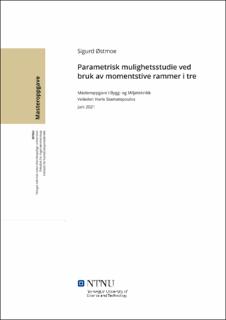| dc.description.abstract | De siste tiårene har tre som konstruksjonsmateriale hatt en stor positiv utvikling og en rekke nytenkende metoder og anvendelser er tatt i bruk i høye trehus og store strukturer. En viktig grunn er byggebransjens mål om å redusere klimagassutslipp og et økt fokus på bærekraft. En nytenkende anvendelse av tre er å benytte momentstive rammer som horisontal avstivning i bygninger og målet for denne oppgaven er å utforske et slikt system.
WoodSol, kort for Wood Frame Solutions for free Space Design in Urban Buildings, er et forskningsprosjekt lansert i 2016 med mål om å utvikle et miljø- og økonomivennlig byggesystem som har fleksibel arkitektur med mulighet for åpne innvending områder og fasader og lengre spennvidder på dekkene. Systemet benytter seg av kontinuerlige søyler med momentstive forbindelser til dekkene. Resultatet er en rammekonstruksjon som fungerer som avstivning i rammeretningen, men er avhengig av avstiving via andre former i vinkelrett retning. Grunnet trevirkets medium-stivhet og lav-vekt blir ofte kriterier i bruksgrensetilstand (SLS) kritisk. Denne grensetilstanden legges vekt gjennom oppgaven, der forskyvninger og vibreringer på grunn av vindbelastning som kan skape ubehag for byggets brukere vil bli vurdert. I tillegg er systemets respons i bruddgrensetilstand (ULS) undersøkt. Her er elementenes utnyttelsesgrad og dimensjonerende lasttilfelle interessante punkter. Byggenes respons blir til slutt sammenlignet med tidligere utarbeidet analytiske uttrykk for horisontal forskyvning, frekvens og akselerasjon.
For å utforske WoodSol systemet ble en rekke bygninger med forskjellige geometri, tverrsnittkombinasjoner, opplagerbetingelser og avstivingsmetoder analysert i programvaren Robot Structural Analysis. Et parametrisk designskript i Dynamo Sandbox ble produsert med et formål om å forenkle modellgenerasjonen av byggene. Dette åpner for geometriske og strukturelle endringer uten å bygge opp modeller manuelt. I studie av systemet er det lagt vekt på påvirkninger av geometriske endringer som høyder og antall etasjer, lengde i rammeretning og spennvidder på dekkene samt byggets bredde. Vinkelrett på rammene ble avstivningsmetoder ved bruk av diagonaler og massivtre (CLT) benyttet.
Analysene av systemet viser klart av SLS- kriterier styrer design og utforming av WoodSol, med relativ-etasje-forskyvning og akselerasjon som kritiske kriterier. Byggens lengde og høyde vil ha stor effekt på SLS- kriteriene og en konservativ anbefaling der avstiving i rammeretning ikke er brukt, er å bruke ett H/L forhold nærmere 1. Det vil også være å anbefale momentstivhet i opplagerbetingelsene. Avstiving i rammeretning vil ha god innvirkning på kriteriene men har behov for mer utforskning i detaljer. ULS vil først være interessant lenge etter SLS- kriteriene er overgått.
Sammenligningen mellom analytisk uttrykk og resultater viser til god overensstemmelse, men varier litt med endring i søyletverrsnitt tverrsnitt og opplager. Der forholdet avviker vil uttrykkene ofte overestimere som er gunstig for videre design av systemet. | |
| dc.description.abstract | Wood as a construction material has progressed significantly in recent decades, and a variety of creative technologies and applications have been used in tall timber houses and large structures. The construction industry's goal of lowering greenhouse gas emissions and a greater focus on sustainability are two major reasons. The use of moment-rigid frames as horizontal bracing in timberstructures is an innovative use of timber and this thesis aims to investigate such a system.
WoodSol, which stands for Wood Frame Solutions for Free Space Design in Urban Buildings, is a research project that began in 2016 with the goal of establishing an environmentally and economically sustainable building system with open objection areas and facades, as well as larger spans. Continuous columns with moment-rigid connections to the decks are used in the system. The result is a frame that acts as bracing in the frame direction but relies on other bracingmethods in the perpendicular direction. Criteria in the service limit state (SLS) are most likely crucial due to the timbers medium-stiffness and low-weight. These citerias are highlighted throughout the assignment, which will take into account displacements and vibrations caused by wind loads that could cause discomfort to the building's occupants. The response of the system in the ultimate limit state (ULS) is also explored. The utilization rate of the elements and the dimensioning load case are both important considerations here. Finally, the buildings' responses are compared to analytical formulas for horizontal displacement, frequency, and acceleration that have been previously prepared.
A variety of buildings with various geometries, cross-sectional combinations, boundary conditions, and bracing methods were examined in the Robot Structural Analysis software to learn more about the WoodSol system. With the goal of simplifying the model creation of the buildings, a parametric design script in Dynamo Sandbox was created. This allows for geometric and structural modifications to be made without having to manually develop models. The effects of geometric changes such as heights and number of floors, length in the frame direction and deckspans, as well as the building's width, has been highlighted in the research of the system. Bracing methods using diagonals and Cross-laminated-timber (CLT) were used perpendicular to the frames.
SLS criteria clearly define the design and layout of WoodSol, with relative floor displacement (ISD) and acceleration as essential factors, according to the system's analyses. The length and height of the building will have a significant impact on the SLS requirements, and if bracing in the frame direction is not employed, a conservative guideline is to use one H/L ratio closer to 1. It will also be recommend to use moment stiffness in boundary conditions. Stiffening in the frame direction will have a positive impact on the criterion, but it will need to be investigated further. Long after the SLS criteria have been met, ULS will become critical.
The consistency between analytical expression and results is good, however it fluctuates significantly when column cross-section and circulation alter. Where the ratio deviates, the expressions will frequently overestimate, which is advantageous for future design of the system. | |
